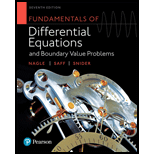
Fundamentals Of Differential Equations And Boundary Value Problems, Books A La Carte Edition (7th Edition)
7th Edition
ISBN: 9780321977182
Author: Nagle, R. Kent, Saff, Edward B., Snider, Arthur David
Publisher: PEARSON
expand_more
expand_more
format_list_bulleted
Concept explainers
Question
Chapter 13.1, Problem 9E
To determine
The approximated solution of the given equation with the help of the successive substitutions method when the initial value
and
Expert Solution & Answer
Want to see the full answer?
Check out a sample textbook solution
Students have asked these similar questions
answer a, b, and c
A population of muffles (a feathery species unrelated to tribbles) begins with 30 animals and has 100
animals after 36 hours.
A population of muffles (a feathery species unrelated to tribbles) begins with 30 animals and has 100
animals after 36 hours.
1. Find a formula describing the growth of the muffle population (4 points). Round any decimals to
five decimal places.
Chapter 13 Solutions
Fundamentals Of Differential Equations And Boundary Value Problems, Books A La Carte Edition (7th Edition)
Ch. 13.1 - In Problem 1-4, express the given initial value...Ch. 13.1 - In Problem 1-4, express the given initial value...Ch. 13.1 - Prob. 3ECh. 13.1 - Prob. 4ECh. 13.1 - Prob. 5ECh. 13.1 - Prob. 6ECh. 13.1 - Prob. 7ECh. 13.1 - Prob. 8ECh. 13.1 - Prob. 9ECh. 13.1 - Prob. 10E
Ch. 13.1 - In Problems 11-16, compute the Picard iterations...Ch. 13.1 - Prob. 12ECh. 13.1 - Prob. 13ECh. 13.1 - Prob. 14ECh. 13.1 - Prob. 15ECh. 13.1 - Prob. 16ECh. 13.1 - Prob. 17ECh. 13.1 - Prob. 18ECh. 13.1 - Prob. 19ECh. 13.1 - Prob. 20ECh. 13.2 - Prob. 1ECh. 13.2 - Prob. 2ECh. 13.2 - Prob. 3ECh. 13.2 - Prob. 4ECh. 13.2 - Prob. 5ECh. 13.2 - Prob. 6ECh. 13.2 - Prob. 7ECh. 13.2 - Prob. 8ECh. 13.2 - Prob. 9ECh. 13.2 - Prob. 10ECh. 13.2 - Prob. 11ECh. 13.2 - Prob. 13ECh. 13.2 - Prob. 14ECh. 13.2 - Prob. 15ECh. 13.3 - Prob. 1ECh. 13.3 - Prob. 2ECh. 13.3 - Prob. 3ECh. 13.3 - Prob. 4ECh. 13.3 - Prob. 5ECh. 13.3 - Prob. 6ECh. 13.3 - Prob. 7ECh. 13.3 - Prob. 8ECh. 13.4 - In Problems 1-6, let (x,y0) be the solution to the...Ch. 13.4 - Prob. 2ECh. 13.4 - Prob. 3ECh. 13.4 - Prob. 4ECh. 13.4 - Prob. 5ECh. 13.4 - Prob. 6ECh. 13.4 - Prob. 7ECh. 13.4 - Prob. 8ECh. 13.4 - Prob. 9ECh. 13.4 - Prob. 10ECh. 13.4 - Let f(x,y)=y2. Solve explicitly for (x,y), the...Ch. 13.4 - Prob. 12ECh. 13.4 - Prob. 14ECh. 13.4 - Prob. 16ECh. 13.RP - In Problems 1 and 2, use the method of successive...Ch. 13.RP - Prob. 2RPCh. 13.RP - Prob. 3RPCh. 13.RP - In Problems 3 and 4, express the given initial...Ch. 13.RP - Prob. 5RPCh. 13.RP - In Problems 5 and 6, compute the Picard iterations...Ch. 13.RP - Prob. 7RPCh. 13.RP - In Problems 7 and 8, determine whether the given...Ch. 13.RP - Prob. 9RPCh. 13.RP - Prob. 10RPCh. 13.RP - Prob. 11RPCh. 13.RP - Let (x) be the solution to y=xsiny, y(0)=y0, and...
Knowledge Booster
Learn more about
Need a deep-dive on the concept behind this application? Look no further. Learn more about this topic, subject and related others by exploring similar questions and additional content below.Similar questions
- Find the radius of circle carrow_forward6 + 3 ² 3679 a 2 च 2 Find the value of x, round to the nearest tenth. 7. 360 L 173² 2 = 7.1 7x-20 8. Q 9 T 9 P 3 360 4 3x x = 3.1 S 34 7+ 7 10. CD = CB, GQ = x +5, EQ = 3x - 6. G LU E B x+5=3x-6 -S-S x = 3x-11 3-3 4A 6.5arrow_forwardFind the sample space. Sunscreen SPF 10, 15, 30, 45, 50 Type Lotion, Spray, Gelarrow_forward
- The graphs of the function F (left, in blue) and G (right, in red) are below. Answer the following questions. F'(1) G'(1) F'(6) G'(6)arrow_forward1. One of the partial fractions for 2 4x²+x-9 x3+2x²-3x 2 x+1 a) x23 b) x 1½ c) x² d) x-1 x isarrow_forward1. One of the partial fractions for 2 2 4x²+x-9 x3+2x²-3x a) x3 b) x11 c) x² d) z x-1 2. Identify the improper integral. 1 x 2 x dx a) 3x dx b) f² 3x dx 0 3-2x 0 3-2x x is c) √2^: 4 √232x dx d) fo² 3x dx 1 1 0 3-2x B. So eax dx converges to if : a) O if a0 c) - 1½ ifa 0arrow_forward
- Complete the square and find the indefinite integral. (Remember to use absolute values where appropriate. Use C for the constant of integration.) dx x²-12x+27arrow_forwardComplete the table. Enter DNE if a quantity doesn't exist or NEI if not enough information is given. f(c) limx-->c- f(x) limx-->c+ f(x) limx -->c f(x) continuity at x=c 2 4arrow_forwardFind the indefinite integral. (Use C for the constant of integration.) 9x arcsin(x) dxarrow_forward
- Find the indefinite integral using the substitution x = 5 sin(e). (Use C for the constant of integration.) 1 dx (25-x²)3/2arrow_forwardFind the indefinite integral using the substitution x = 7 sec(0). (Use C for the constant of integration.) √ ׳ √x² - 49 dxarrow_forwardUse the Cauchy Riemann equations (polar form version). Also, describe what happens at the branch cut.arrow_forward
arrow_back_ios
SEE MORE QUESTIONS
arrow_forward_ios
Recommended textbooks for you
 Algebra for College StudentsAlgebraISBN:9781285195780Author:Jerome E. Kaufmann, Karen L. SchwittersPublisher:Cengage Learning
Algebra for College StudentsAlgebraISBN:9781285195780Author:Jerome E. Kaufmann, Karen L. SchwittersPublisher:Cengage Learning

Algebra for College Students
Algebra
ISBN:9781285195780
Author:Jerome E. Kaufmann, Karen L. Schwitters
Publisher:Cengage Learning
Introduction to Algebra: Using Variables; Author: Professor Dave Explains;https://www.youtube.com/watch?v=WZdZhuUSmpM;License: Standard YouTube License, CC-BY